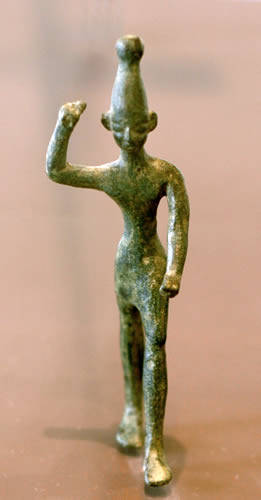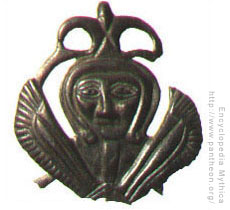A Culture of Language and Trade Phoenicia was an ancient culture, located to the east of the Mediterranean Sea. If Phoenicia existed today, it would be located near Lebanon. The Phoenicians were most famous for inventing the Phoenician language, which formed the base for Greek and Latin scripts. In their time, their main export was a deep purple or maroon dye, used for robes and other kinds of clothing. The Phoenicians were given their name by the Greek; based off of the Greek word for the colored dyes they sold. In the Phoenician language, though, they are known as kena'ani. Note that in many sources, Phoenicians are also known as Canaanites. Anat (Anath): Anat was the warrior goddess, and also a maiden. In the 13th century BCE text, The Epic of Baal, she was said to have killed Yamm, and Zabib, among others. Aretsaya: Aretsaya (also known as Arsai, Arsay, or Arsy) was the goddess of the earth and the underworld. Sometimes she was considered the goddess of the marshes. Ashtart: Ashtart was the goddess of love and war, and the deity of the planet Venus. She is sometimes associated with the Greek goddesses Artemis and Aphrodite. In fact, her birth from an egg was transposed as a less common "birth of Aphrodite" myth. She is depicted as an archeress alongside a lion. Atargatis: Atargatis was the goddess-mother of the earth and the water. Her favorite animals were the dove and the fish. She is sometimes depicted as a mermaid, and sometimes she is considered the source of the goddess Aphrodite. Athirat: Athirat was the mother goddess, and very wise. Her other names include Airat, Ashirat, Asherah, and Sherah. She was the wife and sister of El, and the mother to over 70 gods, including Baal. Baal: Baal was the god of war, thunderstorms, and the harvest. He carried a thunderbolt, much like Zeus. However, he was also commonly associated with Cronos, as he took control of the world by destroying his parents, Heaven and Earth (like Ouranos and Gaia). He was also transposed into Christianity as Beelzebub, a very evil character. Baau and Kolpia: These two are written as a pair, as they are the creation goddess and god, respectively. They were the parents of Genea and Genos. El: El seems to be very similar to Baal, as the two names have been used to describe gods, both of whom do the exact same things. Presumably, then, Baal and El are the same god. Sometimes, however, both names are used within the same myth. I am not sure what the difference is between the two, though El is written as Baal’s father in myths involving them both. Genea and Genos: Genea and Genos were the first humans of Phoenicia. (not gods) Meni: Meni was the god of all luck; good or bad. Misor and Sydyk: These two discovered salt, and were credited for being the first to use it. They were said to have been born from the "Wanderers" who may have been identified with the Titans. Mot: Mot was the god of the dead. Resheph: Resheph was the god of plagues and the underworld. He was a companion to Anath and was also a war god. Taautos: Taautos was a descendant of Misor who created the written language. He is also better known as the Egyptian Thoth. Yamm: Yamm was the god of the seas and rivers. He had an undersea palace. Zabib: Zabib was the goddess of fire. According to a text, called The Epic of Baal, she was killed by Anat. Her name is sometimes read (and no one is sure which rendering is correct, because the Phoenician language had no vowels) as Zebub, or "fly". The website http://home.comcast.net/~chris.s/canaanite-faq.html covers Phoenician mythology in much greater detail.
| Below: Statue of Ba'al  Above: Bronze figure of Anat  |